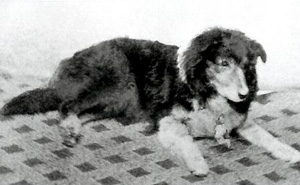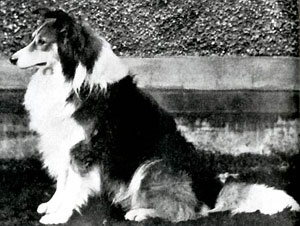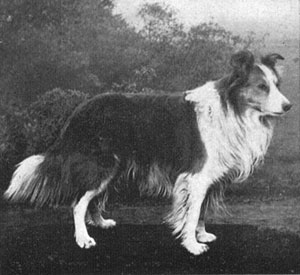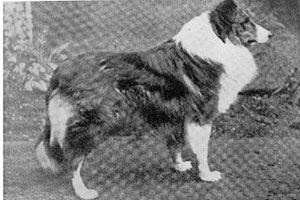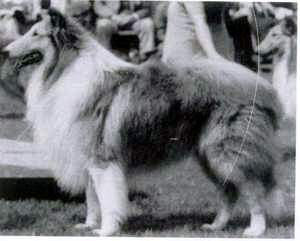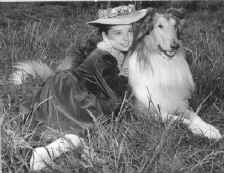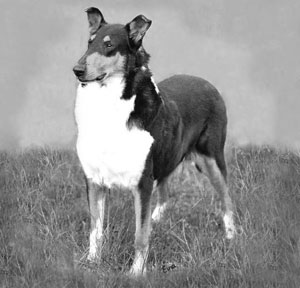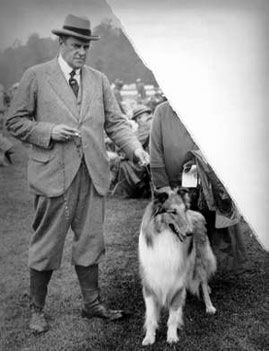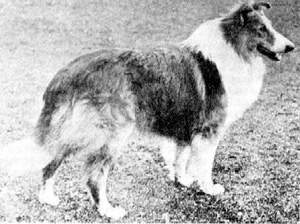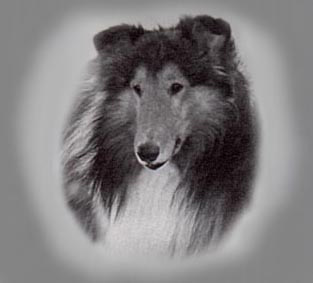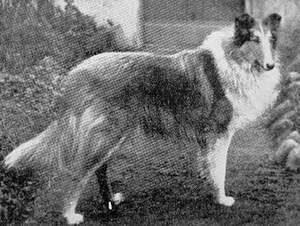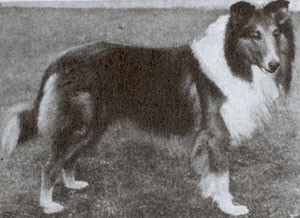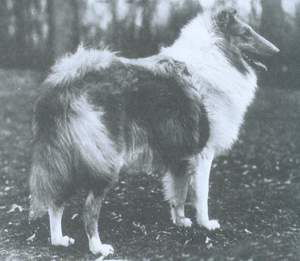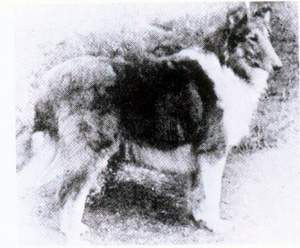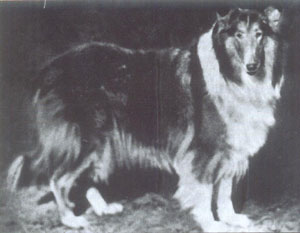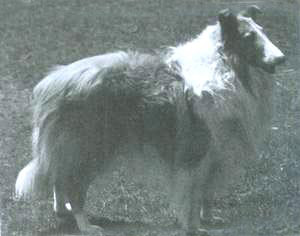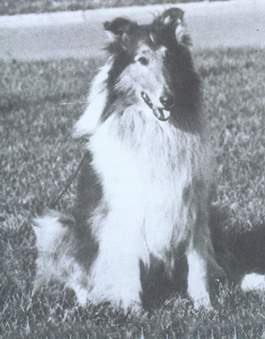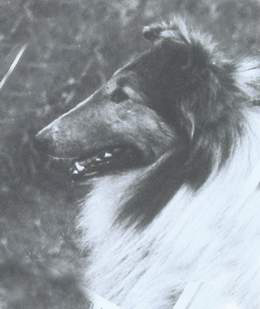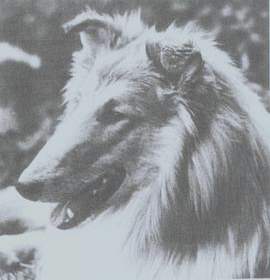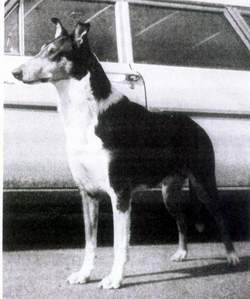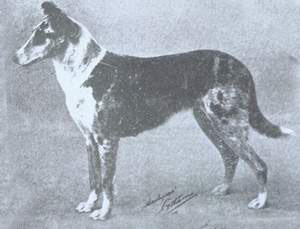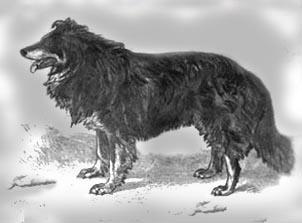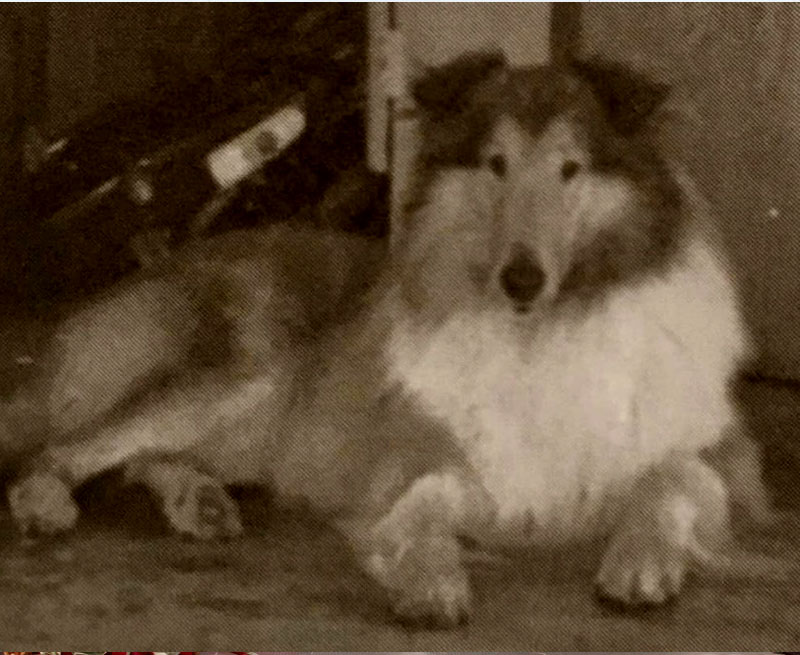"Trefoil" a tri-colour "Galway Collie" born in
1873 Ireland is the undisputed ancestor
of all of today's Collies
Resourced from: "Rough Collies Of Distinction" by Iris Combe, Dareen Bridge and Pat Hutchinson,
"The Magnificent Collie", by Patricia Roberts Starkweather and John Buddie,
"The International Collie Handbook" inclusive article on "Collie History" by Hazel Hunt Collins
"Collie Concept" by Mrs George "Bobbie" Roos
"A History and Description of the Collie or Sheep Dog in His British Varieties"
by Rawdon Lee. 1890
"The Wizard's Castle Pedigree Database" (on line)
Early Collie photos from "The Dog Book", 1906 by James Watson
and "The New Collie" 1993 , by The Collie Club Of America
Ch Black Hawk of Kasan appears courtesy of Sandy Tuttle.
Ch Tartanside The Gladiator appears courtesy of John Buddie.
Thank you to Steve Baxley for the photo of Ravette's Wayside Traveler
Special Thanks to Angela Cartwright
for graciously supplying the photo from the making of the movie, "Lad; A Dog"
Note: In the initial publishing of this page, the name "Dareen Bridge"
was unintentionally omitted from author credits above.
We apologize for any resulting misconception or inconvenience.
"Cockie Boy" a sable & white Collie
born in 1867 , is said to be the first
known Collie of the "brown and white" colour
"Ch Charlamagne" born 4/01/1879
a son of Trefoil and grandson of Old Cockie,
sired Sefton who sired Ch. Metchley Wonder
"Ch. Metchley Wonder" born in 1886, was
a five time winner of the Collie Club Challenge Trophy He sired Ch Christopher
"Ch Christopher" born 1887, was exported to
the U.S. after being bred extensively in Britain.
All Collies today trace back to this dog.
Other testaments to Collie character abound in literature
throughout the history of the breed, showing the true nature of
the breed to be consistent and enduring. In 1922, for example,
Robert Leighton wrote the following in his book,
"Dogs And All About Them":
"Little is known with certainty of the origin of the Collie, but
his cunning and his outward appearance would seem to
indicate a relationship with the wild dog. Buffon was of opinion that he was the true dog of nature, the stock and model of the whole canine species. ... Few dogs possess the fertile, resourceful brain of the Collie. He can be trained to perform
the duties of other breeds. He makes an excellent sporting
dog, and can be taught to do the work of the Pointer and the Setter, as well as that of the Water Spaniel and the Retriever.... He is at his best as a worker, conscious of the responsibility reposed in him; a marvel of generalship, gentle, judicious,
slow to anger, quick to action; the priceless helpmeet of his master--the most useful member of all the tribe of dogs."
"Ch Honeybrook Big Parade" born in 1934,
won the 1939 National Specialty.
He was the son of Ch Future Of Arken,
great grandson of Ch Magnet,
grandsire of Ch Silver Ho Parader, and a major
influence in U.S.. Collie history
Angela Cartwright in 1961 with "Sunnybank Lad"
in the movie "Lad: A Dog" based on
Albert Payson Terhune's well loved book
and much loved Collie
"Ch Black Hawk Of Kasan" born in 1966
was the first Smooth Collie to win Best In Show
at the CCA National Specialty; first Smooth Collie to win an all breed Best In Show, and six times
won Best Of Variety at the National
"Ch Sunnybank Thane" with his breeder / owner
the well known auther Albert Payson Terhune
" Thane" can be found in many pedigrees of
today's Collies, including all those who come down
through Ch Tartanside The Gladiator
"Ch. Wellesbourne Conqueror", born 1895,
a double great grandson of Christopher, was imported
into the U.S, at the age of seven to become
one of the instrumental sires in U.S. pedigrees . .
Collies were extremely popular in the U.S. between the 1930's
and into the 1970's. Many of the top Collies shown as early as
the 30's were of a quality that would easily rival the show winners of today, and up and coming breeders who like to speak of "bettering the breed" would be well advised to take a good look back at these dogs and rather concentrate perhaps on "maintaining" the breed. The 1970's is similarly often referred
to as a time of exceptional quality in Collies, and many who
still remember those dogs speak more of "rekindling" the breeding principles that resulted in that "glory era" than of "bettering the breed".
Eric Knight wrote the well known "Lassie Come Home"
in 1938, during the breed's heyday. It was first published as
a short story in The Saturday Evening Post, and later
developed into a novel. According to Knight's wife, Jere, he modeled "Lassie" after his own Collie, "Toots", whom she described as her husband's inspiration and "shadow". Sadly, Knight, who was a Major in the U.S. army, was killed in action
in 1943 (World War II) and never saw the motion picture based
on his book that MGM released later that year.
It is interesting that the dog in Eric Knight's short story and
book was a tri colour Collie, while the movie featured a sable
and white. One would assume that, had this switch not been made, the tri would today be considered the "preferred colour"
in the hearts of all those who came to know the breed by association with the "Lassie" character. It is also interesting
that the male dogs who portrayed "Lassie" in the movie, and subsequently on television, each had a white blaze on their face,
a marking that was common and perfectly acceptable to the Collie fancy at the time. As time went on, however, the
blaze came to be specifiaclly associated with "Lassie". Collie breeders in the 1940's, working to rid the breed of white haws,
began to consider the blaze (which very often came with them) undesirable in their show dogs. In more recent times, however, the Collie fancy has begun to again accept all manner of white markings, including a blaze on the face, as perfectly acceptable.
Hollywood's "Lassie" did much to both familiarize and endear
more than one generation to the Collie breed. With the advent
of television, American and even international audiences
enjoyed a weekly serving of "Collie drama" that no doubt played
a role in the breed's continuing popularity well into the 1970's.
Although the Hollwood Collie was never up to show standards
in conformation, he did serve as a fitting ambassador in portraying
the breed appropriately as highly intellegent, and amazingly empathetic.
An earlier writer who did much to add to the continuing popularity of the Collie was Albert Payson Terhune. He wrote numerous dog stories and books during the 1920's and 1930's, with many
of them based on the lives and adventures of his own beloved Collies. Terhune was a Collie breeder and exhibitor himself,
and the dogs he wrote about became an introduction to the breed for many who went on to become breeders and
exhibitors themselves. His book "Grey Dawn", a particular favorite, helped to popularize the blue merle colour, and, to this day, many breeders report receiving calls from prospective new Collie owners who want a blue merle puppy based on their love
of Terhune's Grey Dawn.
In his biography on Terhune, titled "The Master Of Sunnybank", Irving Litvag wrote,
.... "You took this Collie dog and you told stories about his greatness and goodness and love and eternal loyalty, and with your story telling skill, you made us actually fall in love with a Collie dog! And he became the dog we always wanted to have and never did. Maybe even more than that.... maybe he
became the friend we always wanted to find, or even the brother or the father. And this authentic-imaginery dog... this Collie
dog took hold of us and won't let go."
Terhune's Collies had that effect of people even when portrayed
by other Collies. When Terhune's book, "Lad: A Dog" was
made into a motion picture in 1961, a young actress by the
name of Angela Cartwright was given a leading role in the movie. She reports the experience started a love affair with the Collie and their Sheltie "cousins" that continues down to this day.
Even Charles Shultz, in his comic strip "Peanuts" mentioned Terhune when Charlie Brown lamented, in 1954, that "The only stories" Snoopy cared to have read to him were those written
by the well known Collie breeder.
Several of Terhune's Sunnybank Collies were campaigned to
their championships, and incorporated into the breeding programs of other fanciers. We can still find a few of them in
our Collie pedigrees today. The property that was once the
home of the Terhunes and the now famous Sunnybank Collies
is maintained as a park and memorial to the author and his dogs. Many Collie fanciers visit "Sunnybank" each year to
view the site where "The Place" once stood, the grounds
where the dogs once froliced, and the graves of
Sunnybank Lad, Sunnybank Grey Dawn, and the others
who's stories have touched and inspired so many.
Throughout the first half of the twentyith century, the Collie's popularity in this country brought much recognition for acts of heroism and deeds consistant with "true Collie character".
The Kennel Ration Dog Hero Of The Year Award, in it's time a well known and highly regarded purveyer of this national honor,
bestowed it's highest distinction to Collie dogs on a number of occasions, more than any other single breed. This recognition
continued to as recently as 1993, when their "First Runner Up" award went to a Collie who saved a baby from choking to death.
(Records beyond that year could not be located for this article).
No U.S. Collie history would be complete without mentioning
Ch Solo of Sheil, a beautiful Smooth Collie born in 1953 and imported to the U.S. where she was bred to
Ch Hertzville Hightop to produce the lovely tri colour male dog,
Ch Glengyle Smooth Sailing. Solo was not the first Smooth imported into this country, but thru her son, she came to be the foundation for the most influential line of Smooths. Ch Glengyle Smooth Sailing's grand daughter, Ch Kasan Fine And Fancy, was bred to Ch High Man Of Arrowhill to produce the tri colour Smooth dog, Ch Black Hawk Of Kasan."Hawk" was the very
first Smooth Collie to win the Collie Club Of America's National Specialty Show, as well as the first Smooth Collie to win a U.S.
Best In Show at an all breed competition. Most Smooth Collies
in the U.S. today, as well as many others throughout the world are descended from this beautiful and exceptionally well structured dog.
Collie History
by Terry Thistlethwaite
While the story of the far travelled tri colour Collie in Erik Knight's"Lassie Come Home" has affixed the country of Scotland in the minds of most as the origin of the Collie breed, the historical record takes us back to a time before the Scots embraced the breed to discover it's foundation. When Celtic tribes invaded the British Isles before the time of Christ, they brought with them livestock dogs that were highly regarded in a society based on a pastoral livlihood. These dogs, in fact, prove to be the early ancestors of the breed that came to be called "Collie". The breed name itself has been
said to possibly have come from the "Coaley" sheep of Scotland, but more likely the name, too, dates back to the Celts, who's word
for "useful" was, in fact, "Collie".
Localized types of "Collie" (or "useful herding dogs") developed
in different areas throughout Great Britian during the Middle Ages with concentrations primarily in Ireland, the north Border country, and Scotland. Historical records speak of the Galway Collies, North Country Collies, Weslh Hillman, Irish Collies, Dorset Sheepdogs, Smithfields (forebears of today's Australian Cattle dogs): Ban Dogs and Rutherfords (forebears of today's Kelpies); Highland Collies (from which came the blue merle colour); and Beards, Shags, and Welsh Grey Collies (forebears of today's Bearded Collies). It was the Galway Collies from which Trefoil, the undisputed ancestor of all modern day Collies decended. Trefoil was born in Ireland in the year 1873, and was an elegantly beautiful rough coated tri colour dog, (black, white and tan) much the same as Erik Knght's fictional Collie, Lassie.
That the primary foundation of the Collie lies in Ireland rather than Scotland is oft debated by researchers, and surely not to be conclusively decided in this article. In researching this debate, however, I came across the writings of H.D. Richardson, who, in an article published in The Irish Penny Journal in 1841 noted,
"...The venerable Bede, as well as the Scotch historian John Major, informs us that Scotland was originally peopled from Ireland under the conduct of Reuda, and adds, that even in his own days half Scotland spoke the Irish language as their mother tongue; and many of my readers are doubtless aware that even at this present time the Gaelic and the Erse are so much alike that a Connaught man finds no difficulty in comprehending and conversing with a Highlander, and I myself have read the Gaelic Bible with an Irish dictionary. Scotland also was called by the early writers Scotia Minor, and Ireland Scotia Major. The colonization, therefore, of Scotland from Ireland, admits of little doubt...."
Thus, even if the modern day version of the Collie began in Scotland, the modern day version of the Scotsman began in Ireland! As the dog was clearly of Celtic origin -- so were both the Irish and the Scottish people. Add to that infusion of the Gordon Setter (a Scottish breed) and the Irish Setter (an Irish breed), both known to have had their place in the development
of the Collie breed, and it seems the breed is best said to be of "Irish / Scottish origin" dating even further back, of course, to the Celts.
One ot the earliest Collies of note was a dog named
"Old Cockie", (also called "Cockie Boy") born in 1868, and
said to be the first known sable and white (or brown and white) coloured Collie. This dog was highly lauded for his endearing expression and fine head detail. He was among the first
"herding breed" dogs to be shown in England., at the Birmingham National Dog Show in 1870. Old Cockie was
the sire of Maude, who was bred to Trefoil to produce a dog named Ch Charlamagne. Born in 1879, Charlamagne became the grandsire to Ch Metchley Wonder, a top winning Collie
who was purchased for such a high price that the sale made headlines. His son, Ch Christopher, born in 1887, was bred extensively in Britain before being exported to the U.S. All Collies today are decended from Ch. Christopher.
A point of interest here is that the mother of Ch Christopher's great grandsire, Scott, was a Smooth Collie by the name of "Ch Waite". She was the very first Smooth Collie champion, and thru Ch. Christopher, is an ancestor of all Collies today. Thus there exist no Rough Collie lines in which Smooth Collies
do not appear.
Queen Victoria had a big influence in popularizing the Collie in the 1880's, and had Smooth Collies as well as white Collies in her Royal Balmoral Kennel.. In the U.S., wealthy fancier J.P. Morgan and his well funded associates imported many top winning British Collies into their mostly New York and eastern seaboard kennels at prices that would be considered
substantial even by today's standards. In 1885 (the same year
the Scottish Collie Club was founded), the breed was
accepted into the American Kennel Club. A year later, 1886,
the Collie Club Of America was born..
"Ch Tartanside The Gladiator" born 1969 ,
was an all breed Best In Show winner , and won the
CCA National Specialty three times,
once from the Veteran's class. He went on to become one
of the most influential Collie sires in the U..S..
Unchanged in character, today's Collie ideally represents a physical standard not much different than what he did in the
late nineteenth century. Below is the breed standard as it was written for the Collie in 1890 by the Scottish Collie Club:
-----------------------------
Collie Standard, 1890, Collie Club Of Scotland
Rough-Coated
Head moderately long in proportion to the dog's size, covered with short soft hair. Skull flat, moderately wide between the
ears, and gradually tapering to the eyes.
There should be a very slight elevation of the eyebrows,
and very little stop.
Muzzle of fair length, tapering to the nose, which,
whatever the colour of the dog, should be black. The
teeth, which are white and of good size, should not be
over nor undershot. Both are faults, the latter the greater
of the two.
Eyes, of fair size, but not prominent, are placed rather close together, and set obliquely in the head, which gives that
cunning foxy expression so characteristic of the breed. Colour, any shade of brouwn, the darker the better, yellow eyes being
a great fault. Dogs of a mirled colour should have a mirled or china eye, and sometimes both eyes
are of this colour.
Ears small, placed rather close together at the top of
the head, covered with short soft hair, and carried semi-erect when at attention; at other times thrown back, and buried in
the frill.
Neck long, arched, and muscular.
Body rather long than short, ribs well rounded, chest
deep and narrow in front, but of a fair breadth behind the shoulders, which should be oblique. Loin rather long,
and slightly arched, showing power.
Legs.--Fore legs straight and muscular, with a fair amount of
flat bone, the fore-arm moderately fleshy, the hind legs less fleshy, very sinewy, and hocks well bent. Pasterns long and
light in bone. Feet oval in shape, the soles well padded, and
the toes well arched and close.
Tail, moderately long, carried low when the dog is quiet, gaily when excited, and almost straight out when running.
Coat.--This is a very important point. The coat, except on the head and legs, should be abundant, the outer coat harsh to the touch, the inner coat soft and furry, and very close, so close
that it is difficult on parting the hair to see the skin. The hair
very abundant around the neck and chest; this is termed the
frill. The mask is smooth , the fore legs slightly feathered, the hind legs below the hocks smooth. Hair on the tail very profuse, and on the hips long and bushy.
Colour.--Any color.
Size.--Dogs 21 to 24 inches at shoulder, bitches 2
inches less.
Weight.--Dogs 45 lb. to 60 lb., bitches 40 lb. to 50 lb.
General Appearance.--A lithe active dog, with no useless
timber about him, his deep chest showing strength, his sloping shoulders, and well-bent hocks speed, and his "bawsint" face high intelligence. The face should bear a sharp, doubtful expression. As a whole, he should present an elegant and pleasing outline, quite distinct from any of our other domesticated breeds, and show great strength and activity.
Faults.--Domed skull, high peaked occipital bone, heavy pendulous ears, full soft eyes, heavy feathered legs,
short tail.
Scale of Points
Head 15
Eyes 5
Ears 10
Neck and shoulders 10
Body 10
Legs and feet 15
Tail 5
Coat 20
Size and general appearance 10
Total 100
Smooth-Coated
The smooth collie only differs from the rough in its coat, which should be hard, dense, and quite smooth
-----------------------------------------------
Unchanged is that the Rough is judged by the same
standard as the Smooth, with coat being the only difference. Colour, which was not of any consideration in the 1890's standard, is now elaborately defined in four categories, with much debate occurring regarding the showing of sable merles, and especially sable merles with blue, or partly blue eyes. Clearly we see here that the breed's founders had no concern over such things, as they allowed "any colour" of Collie, and accepted "mirled or china eye" in any dog that was a
"mirle" -- with no distinction being made that the dog had to
be "blue" merle in order to have blue in the eye(s).
Today, many, and likely most Collies still maintain the
herding instinct that was intrinsic to the founding of the
breed. Herding tests and trials are still held in which
Collies are able to prove their natural inherant aptitude,
even tho most have daily jobs more along the lines of
watching over children and keeping the sofa warm. Along
with that instinct, the "fertile resourceful brain" spoken of
by Leighton and the "true heart and soul" spoken of by
Terhune remain likewise intact, as do the beauty and the
elegance that envelop the whole -- The Collie; the "useful
dog" we have come to love and to cherish, and have
dedicated our best efforts to preserve.
"Ch Magnet" born in 1912, is often called the foundation sire of U.S. Collies. Imported from England at the age of nine,his impact was made
on both U'S. and Brithish lines.
"Ch Anfield Model" born in Scotland in 1902,
was Conquerer's grandson.. He influence was
highly sought as he excelled in qualities of
head and expression. He appears on both sides
of the pedigree of Ch Magnet.
"Laund Loyalty Of Bellhaven" , born 1928,
was the only 'Collie ever to win Best In Show at Westminster. It was his first and only appearance in the show ring, as he was retired after threats were made on his life
"Ch Eden Emerald" born in 1922,
was a grandson of Ch Magnet,
and grandsire of Ch El Troubador Of Arken
Most Collies in England and the U.S.
trace back to this prolific sire.
"Ch Halbury Jean" born in 1924,
is often referred to as "the mother of
the U.S.Collie". She was a Collie of outstanding quality, and the dam of El Capitan Of Arken
(who was unshown due to an injury)
"Ch El Ttoubador Of Arken" born in 1930
was a son of El Capitan Of Arken,
and the foundation sire for several well known
Collie lines, most notably thru his son,
Ch Future Of Arken
"Ch Silver Ho Parader" born in 1943
became the foundation for the Parader line,
which, in turn, became the foundation line
for most of the significant US Collie lines today..
"Ch Parader's Golden Image" born in 1945,
was a son of Ch Silver Ho Parader. This dog sired 24 champions, and is behind both Ch Tartanside The Gladiator and Ch Black Hawk of Kasan
"Ch High Man Of Arrowhill" born in 1951,
was a great grandson of Ch Parader's Golden Image, and the sire of Ch Black Hawk Of Kasan
"Ravette's Wayside Traveler"
was the grandson of another Ch Silver Ho Parader
son, Parader's Future Sensation.
He became the double grandsire of
Ch Tartanside The Gladiator
"Ch Shamrock Smooth Rocket U.D."
(1957) was a graduate Guide Dog For The Blind
and the first Champion Collie to earn the
Utility obedience degree from the AKC.
He sired multiple champions, obedience titlists,
guide, therapy, and service dogs.
"Ch Laund Lynne", born 1917 in England,
This beautiful blue merle Smooth Collie would surely be competitive in today's show ring.
She had no fewer than 95 Best In Show
(or "Best Female In Show") wins
and worked as a sheep and cattle herder.
She retired from the show ring at the age of ten
to successfully raise a liter of seven puppies.
Both Ch Black Hawk Of Kasan and
Ch Tartanside The Gladiator are, either separately or together,
behind the foundation of most American Collies today,
They are also prominently behind many international
pedigrees, as well.
You're listening to:
"The Galway Races"
(Irish folk song)
